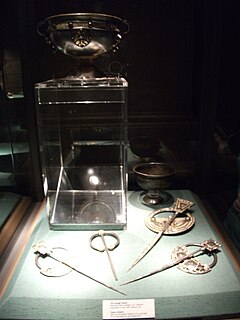 W
WThe Ardagh Hoard, best known for the Ardagh Chalice, is a hoard of metalwork from the 8th and 9th centuries. Found in 1868 by two young local boys, Jim Quin and Paddy Flanagan, it is now on display in the National Museum of Ireland in Dublin. It consists of the chalice, a much plainer stemmed cup in copper-alloy, and four brooches — three elaborate pseudo-penannular ones, and one a true pennanular brooch of the thistle type; this is the latest object in the hoard, and suggests it may have been deposited around 900 AD.
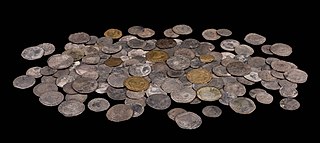 W
WThe Breckenbrough Hoard is a hoard of gold and silver coins dating from 1644, during the English Civil War. It is in the collection of the Yorkshire Museum.
 W
WThe Canterbury-St Martin's hoard is a coin-hoard found in the 19th century at Canterbury, Kent dating from the 6th century. The group in the World Museum, Liverpool consists of eight items, including three gold coins mounted with suspension loops for use as pendants. One of these is the Liudhard medalet, the earliest surviving Anglo-Saxon coin. Another coin is in the Bibliotheque Nationale.
 W
WThe Colmar Treasure or Colmar hoard is a hoard of precious objects buried by Jews of the Holy Roman Empire at the time of the Black Death pogroms.
 W
WThe Derrynaflan Chalice is an 8th- or 9th-century chalice that was found as part of the Derrynaflan Hoard of five liturgical vessels. The discovery was made on 17 February 1980 near Killenaule, County Tipperary in Ireland. According to art historian Michael Ryan the hoard "represents the most complex and sumptuous expression of the ecclesiastical art-style of early-medieval Ireland as we know it in its eighth- and ninth-century maturity." The area known as Derrynaflan is an island of pastureland surrounded by bogland, which was the site of an early Irish abbey. The chalice was found with a composite silver paten, a hoop that may have been a stand for the paten, a liturgical strainer and a bronze basin inverted over the other objects. The group is among the most important surviving examples of Insular metalwork. It was donated to the Irish State and the items are now on display in the National Museum of Ireland.
 W
WThe Erfurt Treasure is a hoard of coins, goldsmiths' work and jewellery that is assumed to have belonged to a Jew of Erfurt, Germany who hid them in 1349 before perishing in the Erfurt massacre, one of the persecutions and massacres of Jews during the Black Death. The treasure was found in 1998 in the wall of a house in a medieval Jewish neighbourhood in Erfurt.
 W
WThe First Cyprus Treasure or Lamboussa Treasure is the name of a major early Byzantine silver hoard found near Kyrenia, Cyprus. Currently in the British Museum's collection, the treasure is largely composed of liturgical objects that may have belonged to an ancient church or monastery. It is called the First Cyprus Treasure to distinguish it from the so-called Second Cyprus Treasure, which is now split between the Metropolitan Museum of Art and the Cyprus Museum.
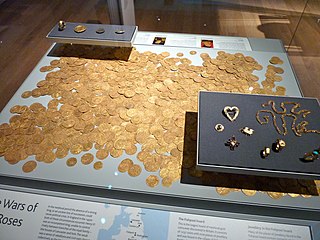 W
WIn 1966 the Fishpool Hoard of 1,237 15th century gold coins, four rings and four other pieces of jewellery, and two lengths of gold chain was discovered by workmen on a building site near present-day Cambourne Gardens, in Ravenshead, Nottinghamshire, England, an area that was then known as "Fishpool". It is the largest hoard of medieval coins ever found in Britain. To judge from the dates of the coins, the hoard was probably buried in haste at some time between winter 1463 and summer 1464, perhaps by someone fleeing south after the Battle of Hexham in May 1464, in the first stages of England's civil war between aristocratic factions, the War of the Roses. The Fishpool Hoard, on display in Room 40 in the British Museum, London, was listed in 2003 among Our Top Ten Treasures, a special episode of BBC Television series Meet the Ancestors that profiled the ten most important treasures ever unearthed in Britain as voted by a panel of experts from the British Museum. The British Museum assesses the face value of the hoard when deposited, about £400, would be equivalent to around £300,000 today.
 W
WThe Treasure of Gourdon is a hoard of gold objects of which date to the end of the fifth or the beginning of the sixth century AD. They were secreted soon after 524. It was unearthed in 1845 near Gourdon, Saône-et-Loire.
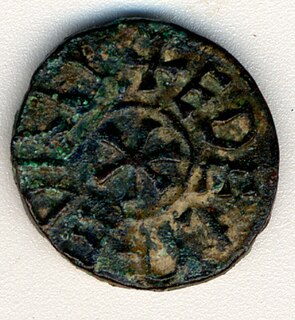 W
WThe Hexham Hoard is a 9th-century hoard of eight thousand copper-alloy coins of the Anglo-Saxon Kingdom of Northumbria, which were discovered whilst a grave was being dug close to Hexham Abbey in 1832.
 W
WThe Lampsacus Treasure or Lapseki Treasure is the name of an important early Byzantine silver hoard found near the town of Lapseki in modern-day Turkey. Most of the hoard is now in the British Museum's collection, although a few items can be found in museums in Paris and Istanbul too.
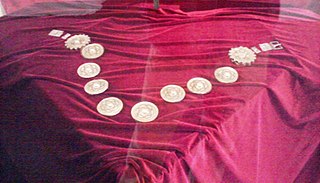 W
WLitva Hoard is a medieval treasure found in Litva (Літва) village in Maladzyechna Raion, western Belarus. It was discovered in the early 1990s and contained a large number of Prague groschens and a large gilded silver belt. It is the largest Prague groschen hoard found in the territory of the former Grand Duchy of Lithuania. They were minted in Kutná Hora during the reigns of John of Bohemia, Charles IV, and Wenceslaus IV (1310–1419). The ornate belt is an example of Islamic art and must have been a gift from the Crimean Khanate. It became known as the Belt of Vytautas because of speculations that it might have belonged to Grand Duke Vytautas though there is no direct evidence to support the claim.
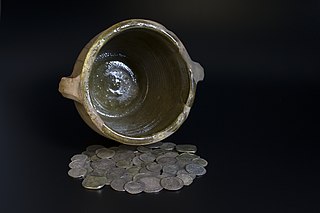 W
WThe Middleham Hoard is a coin hoard found near Middleham, North Yorkshire in England. It dates from the period of the English Civil War, and consists of 5,099 coins, all silver. It is the largest hoard of coins buried during the Civil War to have been discovered. The hoard was discovered in June 1993 by William Caygill while using a metal detector. Though referred to as one hoard, the coins were buried in three pots in two pits. These had slightly different deposition dates; likely in the later 1640s, though the person making the deposits was probably the same. The coins are dispersed between museums and private collections, 54 of them now in the Yorkshire Museum's numismatic collection.
 W
WThe Mitton Hoard is a hoard of silver coins found near Clitheroe in Lancashire, England, in 2006 or 2009. The hoard is now in Clitheroe Castle Museum. The documented treasure consisted of 11 silver coins or parts of coins.
 W
WThe Treasure of Nagyszentmiklós is an important hoard of 23 early medieval gold vessels, in total weighing 9.945 kg, found in 1799 near Nagyszentmiklós, Kingdom of Hungary, meaning "Great St Nicholas". After the excavation, the treasure was transferred to Vienna, the dynastic capital of the Habsburg Monarchy. Ever since, it has been in the possession of the Kunsthistorisches Museum there, where it is on permanent display.
 W
WThe Pereshchepina Treasure is a major deposit of Bulgar, Sassanian, Sogdian, Turkic and Avarian objects from the Migration Period.
 W
WThe Preslav Treasure was found in autumn of 1978 at the vineyard in Castana, 3 km to the north - west of the second Bulgarian capital – Veliki Preslav. The excavations that followed revealed more than 170 golden, silver and bronze objects including 15 silver Byzantine coins belonging to Constantine VII, Romanos II and other artifacts dating far back to the period between 3 rd and 7 th centuries.
 W
WThe Słuszków Hoard is a treasure hoard that was found in the village of Słuszków located in the historical area known as Kalisz Land presently situated in the Greater Poland Voivodeship. The treasure was buried around the year 1100 and was uncovered in 1935. Since 1958, it has been a part of the collection of Kalisz Land Regional Museum. The hoard includes the largest collection of medieval silver coins in Poland as well as the largest collection, in the world, of the so-called "cross denarii" or "cross pennies".
 W
WThe Środa Treasure is a hoard of silver and gold coins, plus gold jewellery and some precious stones. The hoard dates from the mid 14th century. Its largest component is silver coins, of which there are about 3,000 pieces. The hoard was found in years 1985–1988 during renovation works in Silesian town of Środa Śląska, Poland. Today it is mostly kept in the Regional Museum in Środa Śląska.
 W
WThe St Ninian's Isle Treasure, found on St Ninian's Isle, Scotland in 1958 is the best example of surviving silver metalwork from the Early Medieval period in Scotland. The 28-piece hoard includes various silver metalwork items, including twelve pennanular brooches. The treasure is now in the National Museum of Scotland.
 W
WThe Staffordshire Hoard is the largest hoard of Anglo-Saxon gold and silver metalwork yet found. It consists of almost 4,600 items and metal fragments, amounting to a total of 5.1 kg (11 lb) of gold, 1.4 kg (3 lb) of silver and some 3,500 pieces of garnet cloisonné jewellery.
 W
WThe Sutri Treasure is an important Lombardic hoard found at Sutri, Italy in the late nineteenth century that is currently in the collections of the British Museum in London.
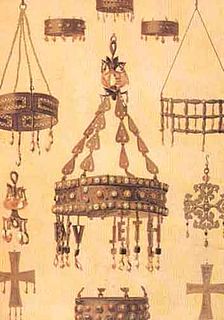 W
WThe Treasure of Guarrazar, Guadamur, Province of Toledo, Castile-La Mancha, Spain, is an archeological find composed of twenty-six votive crowns and gold crosses that had originally been offered to the Roman Catholic Church by the Kings of the Visigoths in the seventh century in Hispania, as a gesture of the orthodoxy of their faith and their submission to the ecclesiastical hierarchy. The most valuable of all is the votive crown of king Recceswinth with its blue sapphires from Sri Lanka and pendilia. Though the treasure is now divided and much has disappeared, it represents the best surviving group of Early Medieval Christian votive offerings.
 W
WTreasure of Halikko is the most valuable treasure found in Finland and one of the most notable treasures in the Nordic countries. It was found in 1887 from Halikko and it is dated to the 11–12th century. The treasure includes three heavy silver crosses from which one was gilded, a necklace with beads. The cross with golden embossments is probably from Central Europe while the other two are thought to have been from other Nordic countries. The necklace is most likely from the southern parts of the Baltic Sea or from the Byzantine Empire.
 W
WThe "Treasure of Pouan" consists of a number of gold and garnet cloisonné jewels and ornaments, buried with a skeleton uncovered in 1842 at Pouan-les-Vallées and identified as the burial of a 5th-century Germanic warrior. Although the warrior had in the past been identified as that of Theodoric I, modern historians generally believe that this is unlikely. The find is now housed in the Musée Saint-Loup, Troyes.